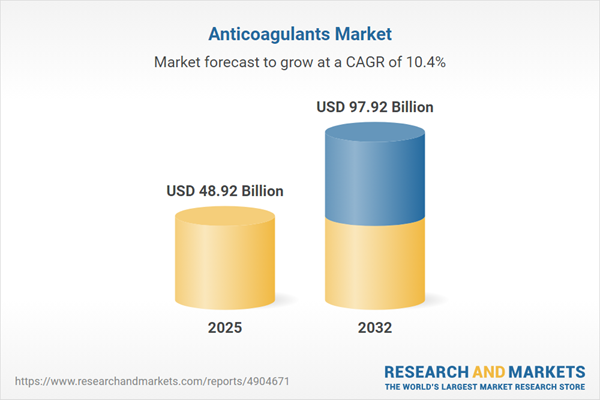Speak directly to the analyst to clarify any post sales queries you may have.
The anticoagulants market is rapidly changing, urging senior leaders in healthcare to reevaluate strategic priorities as they encounter ongoing regulatory evolution, care delivery transformation, and impactful pharmaceutical advances. Organizations face increasing pressures to maintain operational resilience, secure patient access, and optimize therapeutic outcomes in a globalized and dynamic environment.
Market Snapshot: Anticoagulants Market Size and Outlook
The global anticoagulants market reached USD 44.24 billion and is projected to grow to USD 48.92 billion by 2025, with further expansion anticipated to USD 97.92 billion by 2032. This trajectory is fueled by a compound annual growth rate (CAGR) of 10.44%
. Market advancement comes from the integration of new therapy options, the wider acceptance of direct oral anticoagulants, and the increasing demand for adaptable care models. Supply chain efficiency continues to support stable product delivery, while escalating competition and shifting regulatory landscapes motivate healthcare organizations to update operational practices and safeguard steady access to essential therapies.Scope & Segmentation of the Global Anticoagulants Market
- Drug Class: Includes direct oral anticoagulants, low molecular weight heparin, unfractionated heparin, and vitamin K antagonists. These therapies offer tailored options for various patient needs, contributing to more personalized anticoagulant management across different clinical profiles.
- Route of Administration: Features intravenous, subcutaneous, and oral formulations, which accommodate flexible care protocols applicable in hospitals, outpatient settings, and home-based care initiatives globally.
- Indication: Addresses a broad spectrum of clinical interventions such as atrial fibrillation, pulmonary embolism, deep vein thrombosis, and venous thromboembolism. This diverse application supports both preventive and acute care objectives.
- End User: Spans hospitals, ambulatory surgical centers, clinics, and homecare providers, each creating delivery frameworks to optimize care quality and operational effectiveness for distinct patient settings.
- Distribution Channel: Leverages offline pharmacy networks and e-commerce channels to improve therapy accessibility in both urban hubs and underserved, remote communities.
- Regions: Encompasses the Americas, Europe, Middle East and Africa, and Asia-Pacific, each offering unique regulatory standards, reimbursement protocols, and commercial environments that influence region-specific strategies.
- Key Companies: Leading organizations include Johnson & Johnson, Bayer AG, Boehringer Ingelheim GmbH, Bristol-Myers Squibb Company, Daiichi Sankyo Company Limited, Sanofi S.A., Pfizer Inc., Abbott Laboratories, Amgen Inc., Novartis AG, Teva Pharmaceutical Industries Ltd., Dr. Reddy’s Laboratories Ltd., Sun Pharmaceutical Industries Ltd., Lupin Limited, and Cipla Limited. These companies continually refine compliance and supply chain procedures to navigate a highly regulated and competitive marketplace.
Key Takeaways for Senior Decision-Makers
- The growing adoption of direct oral anticoagulants enables tailored treatment planning and supports flexibility for clinicians managing diverse patient groups across multiple settings.
- Established therapies like heparin-based agents and vitamin K antagonists remain cornerstones for specific high-risk groups and serve as critical components in comprehensive protocols.
- Adapting operational structures to align with shifting compliance mandates and payment models allows healthcare organizations to sustain geographic competitiveness and respond to local market dynamics.
- Robust supply chain diversification and sourcing models are essential for reducing the risk of therapy interruption, especially when supply disruptions or regional challenges arise.
- Increased integration of healthcare informatics tools, analytics platforms, and digital procurement solutions streamlines resource allocation and enhances overall operational performance.
- Ongoing collaboration among technology innovators, pharmaceutical companies, and research institutions supports faster adaptation to new standards and ongoing regulatory changes.
Tariff Impact: Navigating 2025 U.S. Tariff Changes
Recent U.S. tariffs on imported pharmaceutical ingredients are prompting manufacturers to modify global supply and sourcing strategies. Organizations are adapting by expanding domestic operations and forging new international partnerships, guided by stronger contracts and rigorous compliance controls. Such measures are vital to ensuring uninterrupted patient care under shifting regulatory requirements.
Methodology & Data Sources
This market analysis combines quantitative modeling with in-depth perspectives from clinicians, procurement specialists, and regulators. All segmentations and data points are verified using leading industry reports, official government resources, and peer-reviewed academic research, providing a reliable basis for strategic decision-making.
Why This Report Matters
- Delivers a comprehensive view of the anticoagulants market, covering commercial, clinical, and operational factors of importance to executive leaders.
- Offers clear guidance for strengthening supply stability, optimizing reimbursement processes, and leveraging technological advancements in therapy management.
- Provides actionable recommendations to support collaboration, adaptability, and proactive response to policy and market developments.
Conclusion
Adopting flexible strategies and focused risk management practices positions healthcare stakeholders to address evolving technology and regulatory demands, while supporting consistent patient outcomes and reliable access in the anticoagulants sector.
Additional Product Information:
- Purchase of this report includes 1 year online access with quarterly updates.
- This report can be updated on request. Please contact our Customer Experience team using the Ask a Question widget on our website.
Table of Contents
3. Executive Summary
4. Market Overview
7. Cumulative Impact of Artificial Intelligence 2025
Companies Mentioned
The companies profiled in this Anticoagulants market report include:- Johnson & Johnson
- Bayer AG
- Boehringer Ingelheim GmbH
- Bristol-Myers Squibb Company
- Daiichi Sankyo Company, Limited
- Sanofi S.A.
- Pfizer Inc.
- Abbott Laboratories
- Amgen Inc.
- Novartis AG
- Teva Pharmaceutical Industries Ltd.
- Dr. Reddy’s Laboratories Ltd.
- Sun Pharmaceutical Industries Ltd.
- Lupin Limited
- Cipla Limited
Table Information
| Report Attribute | Details |
|---|---|
| No. of Pages | 193 |
| Published | October 2025 |
| Forecast Period | 2025 - 2032 |
| Estimated Market Value ( USD | $ 48.92 Billion |
| Forecasted Market Value ( USD | $ 97.92 Billion |
| Compound Annual Growth Rate | 10.4% |
| Regions Covered | Global |
| No. of Companies Mentioned | 16 |









